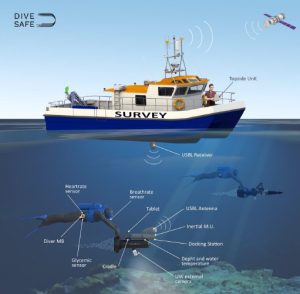EASME/EMFF/2017/1.2.1.12 – Sustainable Blue Economy

Co-funded by the EMFF programme of the European Union
DiveSafe 2nd Newsletter – May 2021


Integrated DiveSafe prototype
The integrated DiveSafe prototype system has been developed to address two market categories, one low-cost and one high-end, with the following modules in common:
- The UW module which includes a) DPV with a Docking Station (DS), b) UW tablet and Navigation App, c) high-resolution camera, d) environmental sensors, e) Diver Motherboard and wearable sensors for breathing, heartbeat and glycemia monitoring, f) an acoustic modem to support both USBL localization and communication.
- A topside unit (a personal computer or a laptop running the Mission Manager app).
- A cloud module that is composed of a) the Remote Server that hosts the database to store all mission plans and data gathered during the missions and b) a 3D reconstruction module that can perform the 3D reconstruction of the underwater site based on photogrammetric documentation.


DiveSafe Updated Reference Architecture and Subsystems
Based on the updated DiveSafe Reference Architecture, the tablet is placed in an underwater case that ensures access to its features through a touch pen. It is anchored on the scooter/Docking Station (DS) through a cradle. The DS is provided with an embedded mainboard that manages all the electronics and implements all the business logic. Two types of DS were produced: DS_Modem (more suitable for low-cost DPV) and DS_USBL (more precise and better with high end DPV). The communication between the DS and the Underwater Tablet is done through a Wi-Fi channel. The Diver_MB is composed of an embedded board that is placed on the diver suite. It enables physiological data logging from wearable sensors and their transmission to the scooter. The acoustic modem is anchored to the scooter.

FAT testing at Istanbul Aquarium
Around the middle of July 2020, we conducted some preliminary Buoyancy and Navigation Factory Acceptance Tests (FATs), at the Istanbul Aquarium. For these specific (pre-)FATs, a Dummy DS_Modem was used, simulating through it the weight and the center of mass of the real DS_Modem. Further tests were then performed with the real DS_Modem in March 2021, including 3D mapping.

FAT testing at the Scanno lake
In November 2020, FAT activities were conducted at the Scanno lake, in the Abruzzo region in Italy. During these FAT activities, we performed extensive tests on high-end and low-cost scooters’ maneuverability, Navigation App and tablet’s usability.



Main Conclusions from FAT testing so far
- The first part of FATs, carried out in the laboratory, concerned the temperature and battery endurance of the devices, as well as their electronical and mechanical stability and their watertightness: in this regard, no problems were reported.
- Regarding system’s buoyancy, the devices were able to remain neutral in the water.
- The navigation and control of the integrated DPV systems is adequate.
- The usability level of the tablet and its app during a mission is acceptable.
- The positioning and communication system was successfully tested and the verification of the messages exchange between Mission Manager and Navigation App was also successful. All messages have been received and displayed.
- The wearable devices (Diver_MB and health sensors) were successfully tested in the laboratory and will be tested very soon in the water.
- The 3D mapping and 3D reconstruction were successfully tested.
- As a consequence from Istanbul FATs, a tripod was designed to safely lay the DPV on the seabed
(e.g. to use the tablet in a static position) and to not damage the fragile marine life.


FAT at Pescara pool
During October 2020, FAT activities were carried out with the cooperation of Italian Carabinieri, at a pool in Pescara. During these activities, Carabinieri tested the maneuverability of both scooters, and they provided important feedback and suggestions. Moreover, data collection tests were performed regarding data collection with all system.

DiveSafe channel on YouTube
The DiveSafe project’s YouTube channel is available at:

DiveSafe participation in Salon de la Plongée 2020
DiveSafe participated with its own booth at the Salon de la Plongée fair. Salon de la Plongée sous-marine is a fair dedicated to scuba diving enthusiasts. The show took place on 11-14 January 2020 in Paris, France. Over 400 international exhibitors gathered for four days between exhibitions and diving seminars. During the fair, members from DANEU project team had several bilateral meetings with resellers and divers, to whom they presented the project, its progress and the integrated DiveSafe system; and discussed about future opportunities for commercial cooperation.

DiveSafe presentation @ European Archaeology Days (EAD), 2020
MiBACT-ICA was involved in the organization of the participation of the Italian Ministry of Culture (MIBACT) in the European Archaeology Days (EAD), held in Paris from 19 to 21st of June 2020. During the event, DiveSafe and its so far achievements were presented, while MiBACT-ICA cooperated with UnivPM and 3DR and prepared a short video of DiveSafe which was presented on the EAD portal. The video is available in the following link: https://www.youtube.com/watch?v=4BPccHDhZtc

DiveSafe was presented at “Dive in Blue Growth” International conference
DiveSafe was presented at the 2nd international conference “Dive in Blue Growth”, which took place online during 12-14/May/2021. The conference welcomed 43 speakers, while there were 490 online registrants and more than 16.000 views of the conference’s livestream. During the presentation ATLANTIS – the Project Coordinator presented an overall description of the project consortium, the main challenges behind the project idea, the DiveSafe solution to be offered to the market including the targeted market segments, and the DiveSafe system architecture and its main components. BURC presented the system’s health sensors and monitoring features including decompression sickness, heart rate and glycemia sensors and breathing monitor. Finally, the main features of the Mission Manager and UW Navigation Apps, were presented by 3DR.
